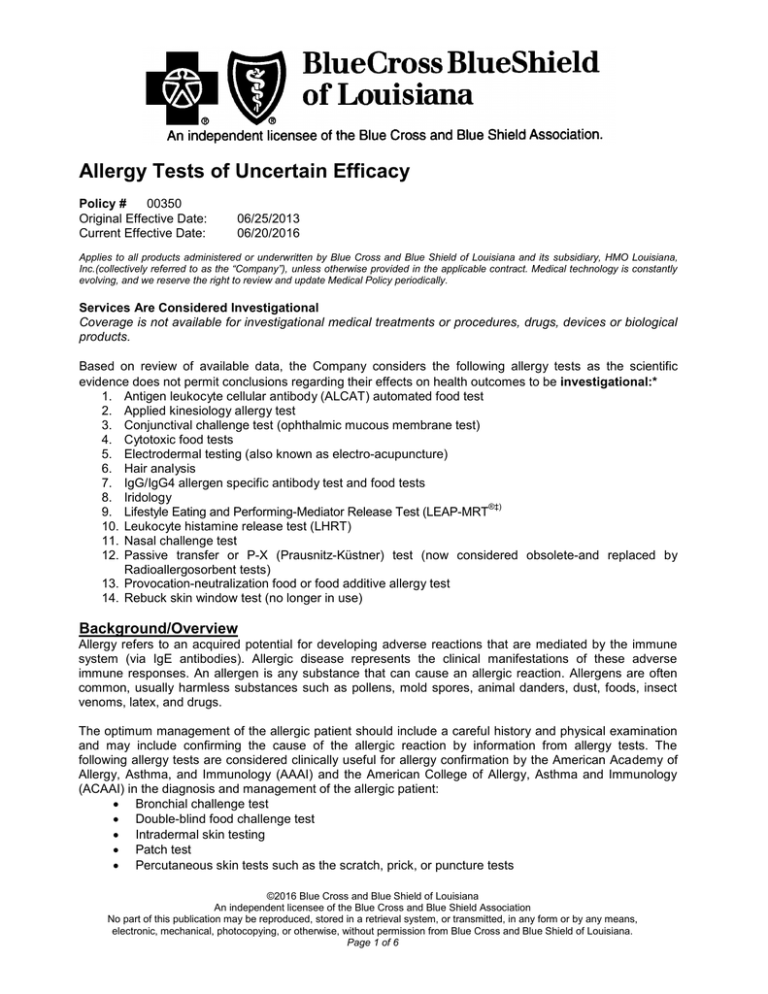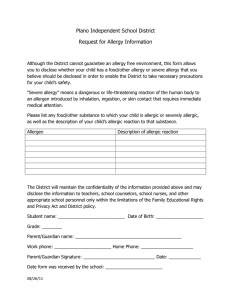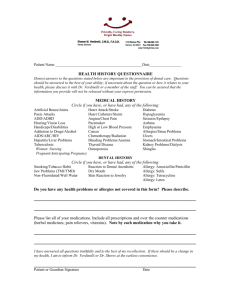Allergy Tests of Uncertain Efficacy
advertisement

Allergy Tests of Uncertain Efficacy Policy # 00350 Original Effective Date: Current Effective Date: 06/25/2013 06/20/2016 Applies to all products administered or underwritten by Blue Cross and Blue Shield of Louisiana and its subsidiary, HMO Louisiana, Inc.(collectively referred to as the “Company”), unless otherwise provided in the applicable contract. Medical technology is constantly evolving, and we reserve the right to review and update Medical Policy periodically. Services Are Considered Investigational Coverage is not available for investigational medical treatments or procedures, drugs, devices or biological products. Based on review of available data, the Company considers the following allergy tests as the scientific evidence does not permit conclusions regarding their effects on health outcomes to be investigational:* 1. Antigen leukocyte cellular antibody (ALCAT) automated food test 2. Applied kinesiology allergy test 3. Conjunctival challenge test (ophthalmic mucous membrane test) 4. Cytotoxic food tests 5. Electrodermal testing (also known as electro-acupuncture) 6. Hair analysis 7. IgG/IgG4 allergen specific antibody test and food tests 8. Iridology ®‡) 9. Lifestyle Eating and Performing-Mediator Release Test (LEAP-MRT 10. Leukocyte histamine release test (LHRT) 11. Nasal challenge test 12. Passive transfer or P-X (Prausnitz-Küstner) test (now considered obsolete-and replaced by Radioallergosorbent tests) 13. Provocation-neutralization food or food additive allergy test 14. Rebuck skin window test (no longer in use) Background/Overview Allergy refers to an acquired potential for developing adverse reactions that are mediated by the immune system (via IgE antibodies). Allergic disease represents the clinical manifestations of these adverse immune responses. An allergen is any substance that can cause an allergic reaction. Allergens are often common, usually harmless substances such as pollens, mold spores, animal danders, dust, foods, insect venoms, latex, and drugs. The optimum management of the allergic patient should include a careful history and physical examination and may include confirming the cause of the allergic reaction by information from allergy tests. The following allergy tests are considered clinically useful for allergy confirmation by the American Academy of Allergy, Asthma, and Immunology (AAAI) and the American College of Allergy, Asthma and Immunology (ACAAI) in the diagnosis and management of the allergic patient: Bronchial challenge test Double-blind food challenge test Intradermal skin testing Patch test Percutaneous skin tests such as the scratch, prick, or puncture tests ©2016 Blue Cross and Blue Shield of Louisiana An independent licensee of the Blue Cross and Blue Shield Association No part of this publication may be reproduced, stored in a retrieval system, or transmitted, in any form or by any means, electronic, mechanical, photocopying, or otherwise, without permission from Blue Cross and Blue Shield of Louisiana. Page 1 of 6 Allergy Tests of Uncertain Efficacy Policy # 00350 Original Effective Date: Current Effective Date: 06/25/2013 06/20/2016 Photo patch test Specific IgE in vitro tests such as Radioallergosorbent Test (RAST), Multiple Radioallergosorbent Tests (MAST), Fluorescent Allergosorbent Test (FAST), Enzyme-linked Immunosorbent Assay (ELISA), and the ImmunoCAP IgE test Total serum IgE concentration Once an allergy-causing agent is identified, treatment is provided by avoidance, medication, or immunotherapy. Allergy Tests of Uncertain Efficacy This policy addresses only allergy tests of uncertain efficacy and those used primarily in research settings. Tests which may be considered useful in the clinical setting, as noted above, are not addressed in this policy. Antigen leukocyte cellular antibody (ALCAT) automated food test The ALCAT automated food test measures whole blood leukocytes by a proprietary process that identifies allergens which cause an increase in leukocyte activity. An electronic counter measures the change in number and size of white blood cells which have been incubated with purified food or mold extracts. A histogram is produced based on cell count and cell size. Individually processed test samples are compared with a "Master Control" graph. Scores are generated by relating these effective volumetric changes in white blood cells to the control curve. Applied Kinesiology (or muscle strength test) Muscle strength in the extremities is measured before and after a person is exposed to an allergen. Strength in the opposing arm is measured as a person holds a container of allergen extract in the opposite hand or ingests an allergen. A decrease in strength indicates the presence of disease and various nutritional supplements may be recommended. Cytotoxic food tests This test involves the response of specially collected white blood cells to the presence of food extracts to which the patient is allergic. A technician observes the unstained cells for changes in shape and appearance of the leukocytes. Swelling, vacuolation, crenation, or other cytotoxic changes in cell morphology are taken as evidence of allergy to the food. Electrodermal testing (also known as electro-acupuncture) Electrodermal testing measures changes in skin resistance while a person is exposed to an allergen, either food or inhalant. This allergy-testing device uses a galvanometer to measure the electrical resistance of the skin. A drop in the resistance of the skin is believed to indicate the presence of allergy. Hair analysis Hair is analyzed for the presence (or lack) of various minerals and toxins. Findings are correlated to nutritional deficiencies or disease. Recommendations for diet and supplements are provided based on the analysis. ©2016 Blue Cross and Blue Shield of Louisiana An independent licensee of the Blue Cross and Blue Shield Association No part of this publication may be reproduced, stored in a retrieval system, or transmitted, in any form or by any means, electronic, mechanical, photocopying, or otherwise, without permission from Blue Cross and Blue Shield of Louisiana. Page 2 of 6 Allergy Tests of Uncertain Efficacy Policy # 00350 Original Effective Date: Current Effective Date: 06/25/2013 06/20/2016 IgG/IgG4 antibody test and food specific IgG/IgG4 tests There are 4 subclasses of immunoglobulin G. Selective deficiencies in one or more of the 4 IgG subclasses are seen in some patients with repeated infections. Measurements of IgG and specifically IgG4 antibodies have been used in research settings as diagnostic and prognostic tests to determine response to allergy treatments. Iridology According to the AAAI, iridology attempts to relate the anatomical features in the iris to various systemic diseases. LEAP-MRT This procedure involves 2 test components. The first component, Lifestyle Eating and Performing (LEAP), tests patients for multiple food and additive/chemical allergies. The patient is tested and then given a ®‡ tailored eating plan. In the second component, the Mediator Release Test (MRT ) measures non-IgE mediated immune pathways using a blood test. Provocative-neutralization tests for food (or food additive allergy test) This procedure is performed by injecting (intradermal or subcutaneous), or placing under the tongue (sublingual), dilute extracts of the suspected food or inhalant allergen and observing the patient’s response or reaction. A symptomatic response indicates an allergy to that food or inhalant, and the reaction can be neutralized by application of a similar extract of a lesser dilution. Allergy Tests in the Research Setting The following tests are primarily used in the research setting: Conjunctival challenge test With conjunctival testing, an allergenic extract is placed into the conjunctival sac of the eye followed by observation for redness, itchiness, tearing of the eye, and other similar symptoms. According to the AAAI, these tests are often used in research protocols that require an objective standard for evaluating clinical sensitivity to an allergen. Leukocyte Histamine Release Test (LHRT) In this testing, leukocytes from the serum of an allergic individual are observed for histamine release in the presence of an antigen. The commercial availability of simplified and automated methods of laboratory analysis has renewed interest in the clinical applications of LHRT in the evaluation of food, inhalant, and drug allergies. The AAAI guidelines for this test indicate it is primarily used in a research setting. Nasal challenge test This test provides precise measurements of changes in nasal airway resistance along with observations such as number of sneezes and measurement of inflammatory mediators in the nasal secretions after exposure to an allergen. The more commonly known "sniff test," uses a visual assessment of mucosal swelling and rhinorrhea after a small amount of dry pollen is inhaled. ©2016 Blue Cross and Blue Shield of Louisiana An independent licensee of the Blue Cross and Blue Shield Association No part of this publication may be reproduced, stored in a retrieval system, or transmitted, in any form or by any means, electronic, mechanical, photocopying, or otherwise, without permission from Blue Cross and Blue Shield of Louisiana. Page 3 of 6 Allergy Tests of Uncertain Efficacy Policy # 00350 Original Effective Date: Current Effective Date: 06/25/2013 06/20/2016 Rationale/Source Scientific Evidence This policy is based on the 2008 AAAAI updated clinical practice guidelines for allergy diagnostic testing, and appraisal of the current scientific evidence published in peer-reviewed journals. The focus of the review was on identifying randomized controlled trials (RCTs) that demonstrate how the tests in question impact treatment decisions and health outcomes in patients with allergies. Literature Appraisal Allergy Tests of Uncertain Efficacy The following tests have either not been evaluated in RCTs examining the clinical utility of the test and/or have been evaluated in RCTs of inferior quality that report inconclusive or contradictory findings: Antigen leukocyte cellular antibody (ALCAT) test Applied kinesiology, Cytotoxic tests, Electrodermal testing , Hair analysis, IgG and IgG4 allergen specific antibody or food test, Iridology, LEAP-MRT, Provocation- neutralization, Allergy Tests In the Research Setting Leukocyte Histamine Release Test (LHRT) Overall, the evidence is not sufficient to permit conclusions on the diagnostic accuracy of LHRT. Studies are potentially prone to spectrum bias, referral bias, ascertainment bias. Alternative tests were not performed in a blinded manner, or studies did not indicate whether t there were blinded interpretations of the tests. Some studies included patients with known allergies, and thus these highly selected populations did not represent the same population with equivocal allergy histories that would undergo testing. In some situations, results were compared with bronchial provocation testing, considered the gold standard for inhalant allergies. However, bronchial provocation may only be performed on a subset of patients with a limited number of allergens. For example, bronchial provocation may only be performed when there are discordant results between RAST and skin prick testing. While it has been suggested that LHRT may be a valuable test in those patients with discordant results of skin prick testing and RAST testing, studies focusing on this subgroup of patients were not identified in a literature search. Conjunctival and Nasal Challenge Tests These tests are often the tools of research protocols and are used to determine clinical sensitivity to an allergen. While it has been suggested that conjunctival and nasal challenge tests may be valuable to confirm diagnosis when skin tests are negative, the studies focusing on this subgroup of patients are small, ©2016 Blue Cross and Blue Shield of Louisiana An independent licensee of the Blue Cross and Blue Shield Association No part of this publication may be reproduced, stored in a retrieval system, or transmitted, in any form or by any means, electronic, mechanical, photocopying, or otherwise, without permission from Blue Cross and Blue Shield of Louisiana. Page 4 of 6 Allergy Tests of Uncertain Efficacy Policy # 00350 Original Effective Date: Current Effective Date: 06/25/2013 06/20/2016 nonrandomized trials which do not permit conclusions on the clinical utility of conjunctival or nasal challenge tests. Summary There is insufficient scientific evidence for all of the allergy tests addressed in this policy. Further there are no evidence-based clinical practice guidelines that recommend these allergy tests; and therefore the following allergy tests are considered investigational: Antigen leukocyte cellular antibody (ALCAT) test Applied kinesiology, Cytotoxic tests, Electrodermal testing , Hair analysis, IgG and IgG4 allergen specific antibody or food test, Iridology, LEAP-MRT, Passive transfer or P-X test, Provocation- neutralization, Rebuck skin window test Leukocyte Histamine Release Test (LHRT) Conjunctival Challenge Tests Nasal Challenge Tests References 1. 2. Regence Medical Policy Manual Laboratory Policy No. 1, Allergy Tests of Uncertain Efficacy, Effective September 1, 2014. Blue Cross and Blue Shield Association, Medical Policy Reference Manual, “Antigen Leukocyte Antibody Test “, 2.01.93, 2:2015. Policy History Original Effective Date: 06/25/2013 Current Effective Date: 06/20/2016 06/06/2013 Medical Policy Committee review 06/25/2013 Medical Policy Implementation Committee approval. New policy. 06/05/2014 Medical Policy Committee review 06/18/2014 Medical Policy Implementation Committee approval. No change to coverage. 06/04/2015 Medical Policy Committee review 06/17/2015 Medical Policy Implementation Committee approval. Added LEAP-MRT to the policy. 06/02/2016 Medical Policy Committee review 06/20/2016 Medical Policy Implementation Committee approval. No change to coverage. Next Scheduled Review Date: 06/2017 Coding The five character codes included in the Blue Cross Blue Shield of Louisiana Medical Policy Coverage Guidelines are ® ‡ obtained from Current Procedural Terminology (CPT ) , copyright 2015 by the American Medical Association (AMA). ©2016 Blue Cross and Blue Shield of Louisiana An independent licensee of the Blue Cross and Blue Shield Association No part of this publication may be reproduced, stored in a retrieval system, or transmitted, in any form or by any means, electronic, mechanical, photocopying, or otherwise, without permission from Blue Cross and Blue Shield of Louisiana. Page 5 of 6 Allergy Tests of Uncertain Efficacy Policy # 00350 Original Effective Date: Current Effective Date: 06/25/2013 06/20/2016 CPT is developed by the AMA as a listing of descriptive terms and five character identifying codes and modifiers for reporting medical services and procedures performed by physician. The responsibility for the content of Blue Cross Blue Shield of Louisiana Medical Policy Coverage Guidelines is with Blue Cross and Blue Shield of Louisiana and no endorsement by the AMA is intended or should be implied. The AMA disclaims responsibility for any consequences or liability attributable or related to any use, nonuse or interpretation of information contained in Blue Cross Blue Shield of Louisiana Medical Policy Coverage Guidelines. Fee schedules, relative value units, conversion factors and/or related components are not assigned by the AMA, are not part of CPT, and the AMA is not recommending their use. The AMA does not directly or indirectly practice medicine or dispense medical services. The AMA assumes no liability for data contained or not contained herein. Any use of CPT outside of Blue Cross Blue Shield of Louisiana Medical Policy Coverage Guidelines should refer to the most current Current Procedural Terminology which contains the complete and most current listing of CPT codes and descriptive terms. Applicable FARS/DFARS apply. CPT is a registered trademark of the American Medical Association. Codes used to identify services associated with this policy may include (but may not be limited to) the following: Code Type Code CPT 83516, 83518, 86001, 86343, 86486, 95060, 95065, 95076, 95079, 95199 HCPCS No codes ICD-9 Diagnosis All related diagnoses ICD-10 Diagnosis All related diagnoses *Investigational – A medical treatment, procedure, drug, device, or biological product is Investigational if the effectiveness has not been clearly tested and it has not been incorporated into standard medical practice. Any determination we make that a medical treatment, procedure, drug, device, or biological product is Investigational will be based on a consideration of the following: A. Whether the medical treatment, procedure, drug, device, or biological product can be lawfully marketed without approval of the U.S. FDA and whether such approval has been granted at the time the medical treatment, procedure, drug, device, or biological product is sought to be furnished; or B. Whether the medical treatment, procedure, drug, device, or biological product requires further studies or clinical trials to determine its maximum tolerated dose, toxicity, safety, effectiveness, or effectiveness as compared with the standard means of treatment or diagnosis, must improve health outcomes, according to the consensus of opinion among experts as shown by reliable evidence, including: 1. Consultation with the Blue Cross and Blue Shield Association technology assessment program (TEC) or other nonaffiliated technology evaluation center(s); 2. Credible scientific evidence published in peer-reviewed medical literature generally recognized by the relevant medical community; or 3. Reference to federal regulations. ‡ Indicated trademarks are the registered trademarks of their respective owners. NOTICE: Medical Policies are scientific based opinions, provided solely for coverage and informational purposes. Medical Policies should not be construed to suggest that the Company recommends, advocates, requires, encourages, or discourages any particular treatment, procedure, or service, or any particular course of treatment, procedure, or service. ©2016 Blue Cross and Blue Shield of Louisiana An independent licensee of the Blue Cross and Blue Shield Association No part of this publication may be reproduced, stored in a retrieval system, or transmitted, in any form or by any means, electronic, mechanical, photocopying, or otherwise, without permission from Blue Cross and Blue Shield of Louisiana. Page 6 of 6



